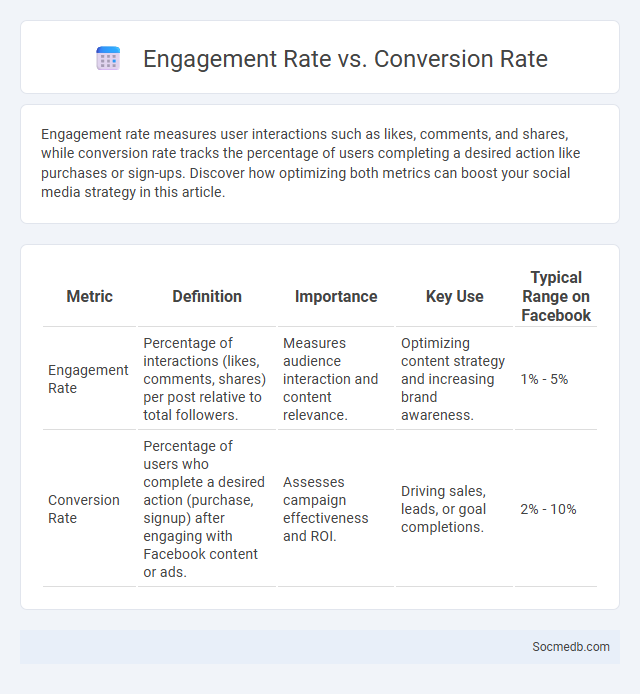
Photo illustration: Engagement Rate vs Conversion Rate
Engagement rate measures user interactions such as likes, comments, and shares, while conversion rate tracks the percentage of users completing a desired action like purchases or sign-ups. Discover how optimizing both metrics can boost your social media strategy in this article.
Table of Comparison
| Metric | Definition | Importance | Key Use | Typical Range on Facebook |
|---|---|---|---|---|
| Engagement Rate | Percentage of interactions (likes, comments, shares) per post relative to total followers. | Measures audience interaction and content relevance. | Optimizing content strategy and increasing brand awareness. | 1% - 5% |
| Conversion Rate | Percentage of users who complete a desired action (purchase, signup) after engaging with Facebook content or ads. | Assesses campaign effectiveness and ROI. | Driving sales, leads, or goal completions. | 2% - 10% |
Understanding Engagement Rate: Definition and Importance
Understanding engagement rate is crucial for measuring the effectiveness of your social media efforts, as it quantifies the level of interaction--likes, comments, shares--relative to your total audience size. This metric provides valuable insights into how well your content resonates with followers and influences brand loyalty, making it essential for refining marketing strategies. Accurately calculating and analyzing engagement rate helps optimize content performance and maximize your social media impact.
What is Conversion Rate? Key Metrics Explained
Conversion rate measures the percentage of social media users who take a desired action, such as making a purchase, signing up for a newsletter, or downloading content. Key metrics influencing conversion rates include click-through rate (CTR), engagement rate, bounce rate, and average session duration, which collectively help analyze user behavior and campaign effectiveness. Tracking these metrics enables marketers to optimize strategies, improve targeting, and increase return on investment (ROI) on social media platforms.
Engagement Rate vs Conversion Rate: Core Differences
Engagement rate measures the level of interaction users have with social media content, including likes, comments, shares, and clicks, reflecting audience interest and content relevance. Conversion rate tracks the percentage of users who complete a desired action, such as making a purchase or signing up for a newsletter, indicating the effectiveness of social media in driving business goals. While engagement rate focuses on user activity and brand awareness, conversion rate emphasizes tangible outcomes and return on investment from social media campaigns.
Why Engagement Rate Matters in Digital Marketing
Engagement rate is a crucial metric in digital marketing because it measures how actively users interact with content, reflecting genuine interest and brand relevance. High engagement rates boost algorithmic visibility on platforms like Instagram and Facebook, amplifying reach without increased ad spend. Brands with strong engagement foster loyal communities, enhance customer insights, and drive higher conversion rates.
How Conversion Rate Drives Business Growth
Conversion rate directly impacts business growth by transforming social media interactions into measurable sales and leads, boosting revenue and market reach. Optimizing your social media strategies to increase conversion rates enhances customer engagement and retention, fueling sustainable expansion. Data-driven insights help tailor content and ads, maximizing the efficiency of your campaigns and driving higher ROI.
Measuring Engagement Rate: Tools and Best Practices
Measuring engagement rate on social media involves tracking key metrics such as likes, comments, shares, and click-through rates using tools like Hootsuite, Sprout Social, and Buffer Analyze. Best practices include normalizing engagement by follower count to assess true audience interaction, setting specific goals based on platform benchmarks, and regularly analyzing data trends to refine content strategy. Consistent monitoring with real-time analytics enables marketers to optimize campaigns and maximize social media ROI effectively.
Strategies to Boost Both Engagement and Conversion Rates
Implement targeted content strategies tailored to your audience's preferences to boost both engagement and conversion rates on social media platforms. Utilize interactive elements such as polls, quizzes, and live videos to foster deeper connections and encourage user participation. Analyze performance metrics regularly to refine campaigns, ensuring your social media efforts effectively drive meaningful interactions and sales.
Common Mistakes When Interpreting Engagement and Conversion Metrics
Common mistakes when interpreting engagement and conversion metrics include confusing high engagement with effective conversions and overlooking the quality of interactions. You might misinterpret vanity metrics like likes and shares as indicators of success, while ignoring key conversion data such as click-through rates and sales figures. Failing to segment audience behavior or track multi-channel interactions can lead to inaccurate conclusions about your social media strategy's true performance.
Case Studies: Engagement Rate vs Conversion Rate in Action
Case studies reveal that higher social media engagement rates do not always translate into increased conversion rates, highlighting the importance of targeted content strategies. Brands like Nike and Glossier demonstrate that personalized storytelling and community building significantly boost conversion by fostering trust and loyalty. Data analytics from platforms such as Instagram and Facebook track user interactions to optimize campaigns, ensuring that engagement effectively drives sales and measurable business growth.
Choosing the Right Metric: When to Focus on Engagement vs Conversion
Choosing the right metric depends on your social media goals, with engagement metrics like likes, comments, and shares indicating audience interaction and brand awareness. Conversion metrics, such as click-through rates, sign-ups, or sales, reveal how effectively your content drives desired actions and ROI. Understanding when to prioritize engagement over conversion helps you tailor your strategy to maximize Your social media impact.
 socmedb.com
socmedb.com